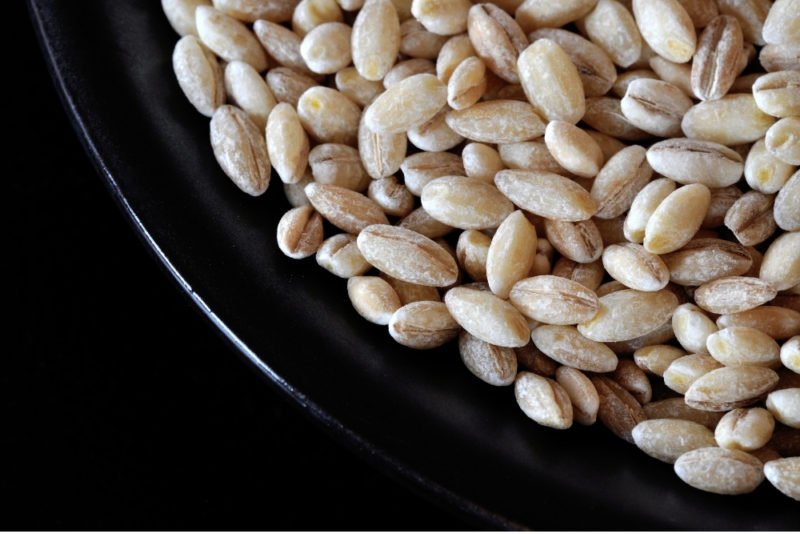
When I was a kid, Campbell’s Soup was a mainstay in our house. Chicken Noodle, Tomato, and Cream of Chicken were my favorites, but it was a sad, sad day when I had to have Beef & Barley for lunch, because that’s all we had left. I think my mother liked Beef & Barley, but me…not so much.
I think that early childhood soup experience predisposed me to think of barley as a lesser grain for quite a long time. Pity, because there were a lot of wasted years before I discovered that barley is, in fact, a fabulous grain. There are so many benefits of eating barley, both for health and for taste. Here’s what you need to know!
Barley in history and the kitchen
Barley has been a staple grain since the Stone Ages, and is one of the first grains cultivated for food. Roman gladiators were called hordearii, which translates to “barley men” or “eaters of barley.” I find this amusing, given how in modern times grains are shunned by many so called “manly men” (I would call them “bros”). Who’s more “manly” than a gladiator?
Barley fell from favor for a while—it was considered “peasant food”—but today we appreciate it for its beta-glucan, a type of soluble fiber. One of the biggest benefits of eating barley is that when beta-glucan mixes with liquids in our digestive tract, it develops a gelatin-like consistency that can remove excess cholesterol (including “bad” LDL cholesterol) from our bodies. Soluble fiber also helps slow the release of sugars into your bloodstream, so it can promote healthy blood sugar levels and steady energy.
That’s lovely, of course, but what I really appreciate about barley is its nutty flavor, chewy texture and ability to absorb the flavors of other ingredients it’s cooked with. Even though my first exposure to barley was in a savory fashion, this grain works as well as breakfast as it does at lunch or dinner. It works as a stovetop porridge, a baked breakfast dish (like baked oatmeal), a base for a hearty summer grain salad, or a warming soup or pilaf. Pearled barley (more on that below) can even be used to make a risotto-like dish.
Note: Barley contains both gluten and oligosaccharides (a type of fiber), so should be avoided by people with celiac disease and some people with irritable bowel syndrome (IBS).

Barley varieties
Barley comes in various forms:
- Hulled (or whole grain) barley has the outer inedible husk removed, but still retains its bran. This form has the most fiber, protein, vitamins and minerals.(Thanks, bran!), but takes longer to cook.
- Black barley is a is an heirloom variety from Ethiopia. It’s a whole grain, and cooks like hulled barley. When cooked, it has a black, shiny appearance that makes it a beautiful addition to a pilaf of mixed grains.
- Purple barley is another type of whole grain barley that comes from Tibet. It has a sweet flavor and beautiful purple color when cooked
- Pearled barley has the bran removed and has been steamed and polished. It cooks quicker but is not a whole grain…just FYI. Pearled barley comes in coarse, medium and fine forms. Coarse barley (aka Scotch barley or pot barley) is only partially pearled. Medium pearled, the most common type of pearled barley, is pearled just until they grains appear white.
- Barley flour or barley meal is ground from pearled barley. Its frequently used in bread, but doesn’t contain enough gluten on it’s own, so it’s usually combined with wheat or rye flour.
- Barley grits (cracked barley) and barley flakes are generally made from hulled barley that has been cracked or rolled, respectively. They make great hot breakfast cereals or thickeners for soups and stews. You can use the flakes in cookies in place of oatmeal.

Barley cooking tips
To speed cooking time for whole grain (hulled) barley, including black or purple barley, soak it for 2-6 hours before cooking, using 3 cups of water per cup of dry barley. Then, cook the barley in the soaking water to minimize loss of nutrients. You can soak it on the countertop unless room temperature is above 75 degrees or so—in that case, soak it in the fridge. Presoaked whole grain barley takes about 50-60 minutes to cook, compared with 90-120 minutes without soaking.
Pearled barley doesn’t need pre-soaking. Again, combine 3 cups water per cup of dry barley, bring to a boil, lower the heat, then cover and simmer until tender but not mushy. Approximate timing is 60 minutes for coarse pearled barley, 50 minutes for medium pearled, and 40 minutes for fine pearled.
There’s an amazing recipe for Barlotto with Braised Greens, Currants and Pine nuts from the book “Vegan Vegetarian Omnivore” in this Seattle Times column I wrote a few years ago. Want more? Grab my “Warming Fall/Winter Barley Recipes” e-book below!
Carrie Dennett, MPH, RDN, is a Pacific Northwest-based registered dietitian nutritionist, journalist, intuitive eating counselor, author, and speaker. Her superpowers include busting nutrition myths and empowering women and men to feel better in their bodies and make food choices that support pleasure, nutrition and health. This post is for informational purposes only and does not constitute individualized nutrition or medical advice.
Seeking 1-on-1 nutrition counseling? Learn more about her Food & Body, IBS management, and nutrition counseling programs, and book an intro call to see if the program is a good fit, and if we’re a good fit!
Want exclusive content on nutrition, health, diet culture and more, plus critiques of nutrition and health journalism? Subscribe to my Food Noise newsletter! 📣






